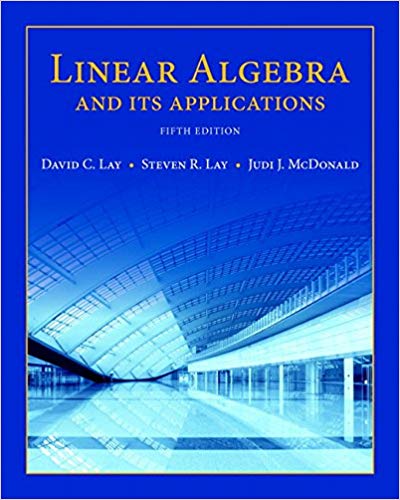
Linear Algebra and Its Applications, 5th Edition
Authors: David C. Lay, Steven R. Lay, Judi J. McDonald
ISBN-13: 978-0321982384
We have solutions for your book!
See our solution for Question 5E from Chapter 6.SE from Lay's Linear Algebra and Its Applications, 5th Edition.
Problem 5E
Chapter:
Problem:
0
Step-by-Step Solution
Given Information
We are given that $U$ is an $n \times n$ matrix. such that \[(U \mathbf{x}) \cdot(U \mathbf{y})=\mathbf{x} \cdot \mathbf{y}\]We have to prove that U is orthogonal matrix.
Step-1:
Using the standard basis of $R^n$, $U \mathrm{e}, \text { is the jth column of U For, } j=1, \ldots \ldots, n$
Substituting in the given property:\[\begin{array}{l}{\left\| {{\rm{U}}{{\rm{e}}_j}} \right\|^2} = \left( {U{{\rm{e}}_j}} \right)\cdot\left( {U{{\rm{e}}_j}} \right)\\ = {{\bf{e}}_j}\cdot{{\bf{e}}_j}\\ = 1\end{array}\]Hence the columns of matrix U are unit vectors.
Step-2:
Also, \[\begin{array}{l}\left( {U{{\bf{e}}_j}} \right)\cdot\left( {U{{\bf{e}}_k}} \right) = {{\bf{e}}_j}\cdot{{\bf{e}}_k}\\ = 0\end{array}\]The columns are pairwise orthogonal. Therefore,
U is orthogonal Matrix
We are given that $U$ is an $n \times n$ matrix. such that \[(U \mathbf{x}) \cdot(U \mathbf{y})=\mathbf{x} \cdot \mathbf{y}\]We have to prove that U is orthogonal matrix.
Step-1:
Using the standard basis of $R^n$, $U \mathrm{e}, \text { is the jth column of U For, } j=1, \ldots \ldots, n$
Substituting in the given property:\[\begin{array}{l}{\left\| {{\rm{U}}{{\rm{e}}_j}} \right\|^2} = \left( {U{{\rm{e}}_j}} \right)\cdot\left( {U{{\rm{e}}_j}} \right)\\ = {{\bf{e}}_j}\cdot{{\bf{e}}_j}\\ = 1\end{array}\]Hence the columns of matrix U are unit vectors.
Step-2:
Also, \[\begin{array}{l}\left( {U{{\bf{e}}_j}} \right)\cdot\left( {U{{\bf{e}}_k}} \right) = {{\bf{e}}_j}\cdot{{\bf{e}}_k}\\ = 0\end{array}\]The columns are pairwise orthogonal. Therefore,
U is orthogonal Matrix